The intersection of hardware and software in computing systems often raises questions about categorization, especially in specialized fields like driver development. One such topic is whether UDMA (Ultra Direct Memory Access) driver development falls under the umbrella of embedded systems engineering. To answer this, we must dissect the nature of UDMA technology, its role in hardware communication, and how it aligns with the principles of embedded development.
Understanding UDMA and Its Applications
UDMA is a protocol designed to optimize data transfer speeds between hardware components, such as storage devices (e.g., hard drives, SSDs) and a system’s memory. By enabling direct memory access without constant CPU intervention, UDMA reduces latency and improves overall system performance. This technology is widely used in environments requiring high-throughput data processing, including servers, desktop computers, and industrial automation systems.

Driver development for UDMA involves creating software that allows an operating system to communicate with hardware controllers supporting the UDMA standard. This includes configuring registers, managing data buffers, and handling interrupts to ensure efficient data transfers.

Embedded Systems Engineering: Core Characteristics
Embedded systems are specialized computing platforms designed for specific tasks, often with constraints on power consumption, size, and real-time performance. Examples include microcontrollers in IoT devices, automotive control units, and medical equipment. Key traits of embedded development include:
- Resource Limitations: Optimized code for minimal memory and processing overhead.
- Real-Time Requirements: Predictable timing for critical operations.
- Hardware-Software Co-Design: Tight integration with custom or proprietary hardware.
The Case for UDMA in Embedded Systems
At first glance, UDMA driver development might seem more aligned with general-purpose computing due to its prevalence in PCs and servers. However, modern embedded systems increasingly demand high-speed data handling. For instance:
- Industrial IoT (IIoT): Sensors and actuators in smart factories generate vast data streams requiring rapid processing.
- Automotive Systems: Advanced driver-assistance systems (ADAS) rely on fast storage access for real-time decision-making.
- Medical Devices: Imaging equipment like MRI machines must transfer large datasets efficiently.
In these scenarios, UDMA drivers become essential to meet performance goals. Developers must adapt UDMA protocols to work within embedded constraints, such as low-power processors or real-time operating systems (RTOS). This involves tailoring drivers to specific hardware architectures—a hallmark of embedded engineering.
Challenges in Embedded UDMA Driver Development
- Hardware-Specific Optimization: Unlike generic drivers, embedded UDMA code often targets custom System-on-Chip (SoC) designs or FPGA-based controllers. This requires deep knowledge of the hardware’s memory map and DMA controller capabilities.
- Real-Time Constraints: Ensuring deterministic timing for UDMA operations is critical in safety-critical systems (e.g., automotive braking systems).
- Power Efficiency: Balancing speed with energy consumption is vital for battery-powered devices.
- Security: Embedded systems in sensitive applications need robust safeguards against data corruption or unauthorized access during DMA transfers.
Case Study: UDMA in a Wearable Health Monitor
Consider a wearable device that continuously records physiological data (e.g., heart rate, oxygen levels). To minimize CPU usage and extend battery life, the device uses UDMA to offload sensor data directly to memory. Here, the driver must:
- Configure DMA channels to prioritize critical data.
- Implement error-checking mechanisms to handle signal noise.
- Integrate with a low-power RTOS scheduler.
This example underscores how UDMA driver development in embedded contexts diverges from conventional PC environments, demanding a unique blend of performance optimization and resource management.
: Bridging Two Worlds
UDMA driver development straddles the line between general-purpose and embedded systems engineering. While the technology itself is not exclusive to embedded platforms, its implementation in resource-constrained, real-time environments undeniably falls under embedded development. As embedded systems grow more complex—driven by AI, edge computing, and high-speed connectivity—the role of UDMA and similar protocols will only expand. Developers in this space must master both hardware intricacies and software efficiency to deliver solutions that meet the dual demands of speed and reliability.
In summary, UDMA driver development is not inherently embedded, but its application within embedded systems transforms it into a specialized subset of the field. This distinction highlights the adaptability of embedded engineering, where tools and protocols are repurposed to solve unique challenges.









